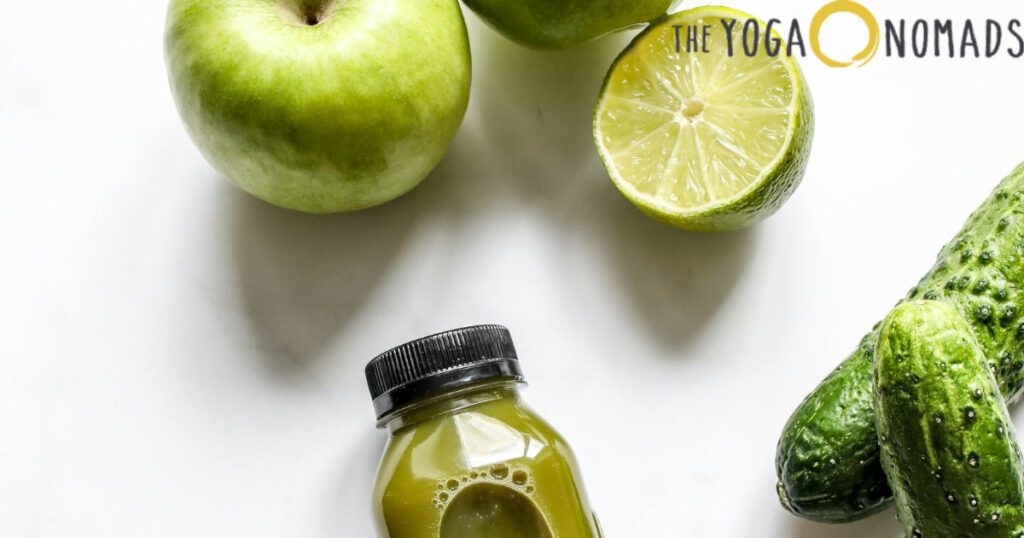3 Ways to Integrate Ayurveda with Yoga for Joint Care
The post 3 Ways to Integrate Ayurveda with Yoga for Joint Care appeared first on The Yoga Nomads.

Listen to a summary of this article:
Key Takeaway
Discover how to enhance joint health by combining Ayurvedic practices with targeted yoga techniques.
Ayurveda and yoga for joints provide holistic, natural solutions to improve joint health and flexibility. When you put these ancient practices together, you can find relief from pain and increased range of motion.
Ayurveda’s natural approach emphasizes balancing your body’s energies and using herbal remedies. Yoga offers gentle, yet effective, movements that help strengthen joints.
Making room for these practices in your daily life will open the door to a deeper sense of wellness. In this article, you’ll learn proven strategies and simple tips to nourish your joints and help you adopt a more dynamic way of living.
Ayurveda’s Joint Health Principles
Knowing your body type, or prakriti, is the first step in Ayurveda for creating a foundation of healthy joints. Knowing which doshas—Vata, Pitta, or Kapha—are predominant in you will allow you to better focus your efforts.
A harmonious daily schedule, or dinacharya, serves as the foundation for all good health in Ayurveda. I’ve found that introducing abhyanga, or self-massage, with sesame oil has incredible benefits for joint lubrication.
Taking up a yoga practice can help improve this even more as mindful movement through the poses can release tension and increase the flexibility of spinal joints. To improve digestion and remove ama (waste buildup) I frequently use the herbal remedy triphala, which Ayurveda emphasizes as essential to achieve optimum joint health.
Breathing exercises, like Ujjayi, help enhance these practices, keeping energy flowing freely and vibrantly throughout the body.
ORGANIC INDIA Triphala Capsules Organic – Herbal Supplement with Amla
Ayurvedic Remedies for Joint Relief
Herbal Ayurvedic remedies, such as guggulu and boswellia, have been the cornerstone of joint health for centuries. Their anti-inflammatory properties are quite amazing. These herbs, usually taken orally, can help manage and reduce joint pain, especially for those suffering from arthritis.
For a simple home remedy, steep ½–1 tsp Triphala powder in boiled water, let it cool, and drink. Ayurvedic Joint Support tablets support healthy inflammatory response throughout the body, utilizing potent herbal ingredients such as guggulu and boswellia.
Yoga for Joint Flexibility and Strength

Regular yoga asana practice is a great approach to strengthen your joints and promote joint health. Over time, it may even lessen arthritis symptoms, through increasing muscle tone, flexibility, and mobility. Joint function can be further improved by including daily Ayurvedic treatments like abhyanga, which can also improve blood flow in the afflicted joints.
Yoga may be tailored to meet the needs of each individual and is accessible to people of all fitness levels. Consider also collaborating with a licensed Ayurvedic practitioner to optimize the advantages.
This individualized method combining yoga and Ayurveda guarantees that you are making the most of every session. Two to three times a week of yoga practice can result in long-lasting gains in strength and flexibility.
Integrated Approach: 3 Tips for Combining Ayurveda and Yoga
Together, Ayurveda and yoga provide an integrated approach to joint health. From my personal experience with this integrated approach, I’ve seen how these practices can pair beautifully together. Yogadownload.com offers a variety of yoga classes that blend Ayurveda principles with holistic wellness practices.
Ayurveda approaches the topic of balance mainly through diet and herbal remedies that aim to reduce inflammation and joint pain at the source. As an example, turmeric is very anti-inflammatory. I love adding this spice to anything I can — including my cooking oil!
Yoga focuses on improving flexibility and developing strength. Moving through various yoga poses helps you build the strength necessary to stabilize and support the body’s joints, especially as you age.
This two-fold approach relieves acute discomfort while increasing resilience. Complementarily, they support all-day, everyday well-being by improving comfort and function in daily life, from work to play.
1. Diet and Lifestyle for Joint Wellness

What you eat and how you live is important. Eating right and living well plays a huge role in joint health. For instance, I’ve noticed that when I add anti-inflammatory foods—turmeric, ginger—to what I eat, it has a major impact. These spices don’t just add flavor to dishes—they work wonders in reducing joint swelling and pain.
Staying hydrated is important as well—from joint cartilage to your skin, drinking water helps keep everything lubricated.
My consistent yoga practice has truly been a miracle creator. Poses such as Downward Dog and Warrior I lengthen and tone the muscles surrounding the joints, offering a layer of armor.
Lastly, I focus on rest and recovery, understanding that my body needs that time to heal. A good diet, drinking lots of water, and practicing yoga all help me set the stage for my joints to do their best.
2. Detoxification and Joint Health
Detoxification is an important part of improving joint health. My personal experience with Ayurveda has been that targeted herbs and dietary choices work wonders at diminishing inflammation.
For example, turmeric, whose active compound curcumin, has anti-inflammatory properties and can help relieve joint pain. Cooking with ginger is another easy way to relieve arthritis pain thanks to its anti-inflammatory effects.
On a personal level, I’ve experienced how proper hydration significantly improves joint function. I find that drinking warm lemon water first thing in the morning gets my metabolism going and helps detoxify my body right away.
Yoga practice increases circulation and flexibility, which is crucial when it comes to keeping your joints healthy and mobile. Poses such as Half Lord of the Fishes and Child’s Pose are especially helpful.
3. Stress, Emotions, and Joint Health
Through my own experiences I have seen how stress affects my joints. Whenever things in life start piling on, all of a sudden my body is tensed up and in pain. Yoga has been my saving grace, allowing me to physically release that pent-up tension.
By fostering a healthy flow of energy with each pose, these practices make movement more effortless and graceful. Ayurveda builds on this with a focus on eating a well-rounded, nutritious diet full of anti-inflammatory foods like turmeric and ginger.
It makes sense that when practicing mindfulness, I am reducing emotional stress, which in turn directly affects my physical well-being. For example, just a few minutes of deep breathing can reduce psychological stress and joint inflammation.
By incorporating these methods into your routine, you create a nurturing habitat for your joints, making them more supple and durable.
Safety and Considerations
As you begin to explore the practice of Ayurveda and yoga for healthy joints, safety should always come first. Through combining these two intentional practices, I’ve learned the value of tuning in to my body.
Practicing Ayurvedic methods has benefited me enormously in getting on top of discomfort, inflammation, and pain. Hydration and a healthy diet are important factors in joint health as well. Make sure you’re providing your body the nourishment it requires with nutritious food and plenty of sleep.
As with any new regimen, it’s important to speak with a health professional before beginning, particularly if you have pre-existing concerns or injuries in your joints. Gentle yoga poses, such as Child’s Pose or Cat-Cow are helpful, but adjustments might be needed. Listen to your body and approach each practice with mindfulness.
Conclusion
Together, Ayurveda and yoga form a powerful approach to joint care. You come away with a deep knowledge of how to alleviate pain, increase flexibility, and strengthen your body. Simple practices such as mindful movement, maintaining a balanced diet and incorporating natural remedies can have a profound effect on how you feel.
Giving precedence to a healthy lifestyle means that you can continue to do the things you love every day without difficulty. Keep in mind that stress and emotional well-being is another large part of your joint wellness. Put these principles into practice, and you’ll be amazed at the difference they’ll make.
So, what are you waiting for? Take the first step toward happier, healthier joints by ordering yours today! Join us to explore the practice of Ayurveda and yoga, and feel the difference yourself. Trust us when we say your body will thank you!
Pop quiz! 🧘🤔
Ayurveda believes that proper alignment in yoga can help prevent joint pain
According to Ayurveda, a diet that includes anti-inflammatory foods is unrelated to joint health
Yoga postures can help improve flexibility, which may reduce the risk of joint injuries
Frequently Asked Questions
What is Ayurveda’s approach to joint health?
Ayurveda aims to restore balance to the body’s energies, or doshas, to support healthy joints and alleviate joint problems. It focuses on holistic treatments, including ayurvedic interventions, lifestyle changes, and dietary recommendations to combat inflammation and improve joint function.
How can Ayurvedic remedies help with joint pain?
In Ayurveda, the use of herbs like turmeric, ginger, ashwagandha, boswellia, guggul, Triphala, shallaki, fenugreek, and devil’s claw has anti-inflammatory properties that can help arthritis patients prevent further joint damage. By including these healing herbs in your daily routine, you can relieve joint pain symptoms, swelling, and stiffness, improving the overall function of your joints.
What yoga poses are best for joint flexibility?
Yoga poses such as Downward Dog, Warrior II, and Cat-Cow are excellent for enhancing joint flexibility and alleviating stiffness, benefiting arthritis patients by targeting the muscles surrounding the affected joints and improving overall range of motion.
How does combining Ayurveda and yoga benefit joint health?
Combining Ayurveda and yoga offers a comprehensive perspective on joint health, particularly for arthritis patients. This unique combination treats physical, emotional, and dietary factors, resulting in increased overall well-being and greater joint function.
What dietary changes support joint wellness?
Incorporating anti-inflammatory foods into our diets, such as colorful produce, whole grains, and healthy fats, can be beneficial for arthritis patients. Cutting out processed foods and sugars helps reduce inflammation, supporting healthy bones.
How does detoxification impact joint health?
Detoxification assists the body in the natural removal of toxins that can lead to inflammation and joint problems. Ayurvedic detox techniques, such as herbal cleanses and periodic fasting, promote healthy bones and rejuvenate the body, encouraging greater joint health.
Can stress affect joint health?
Definitely. Any emotional tension can lead to physical stress through muscle constriction and inflammatory responses, making stress management through yoga practices essential for arthritis patients seeking greater joint health.
Thanks for your feedback!

 MikeTyes
MikeTyes 

































